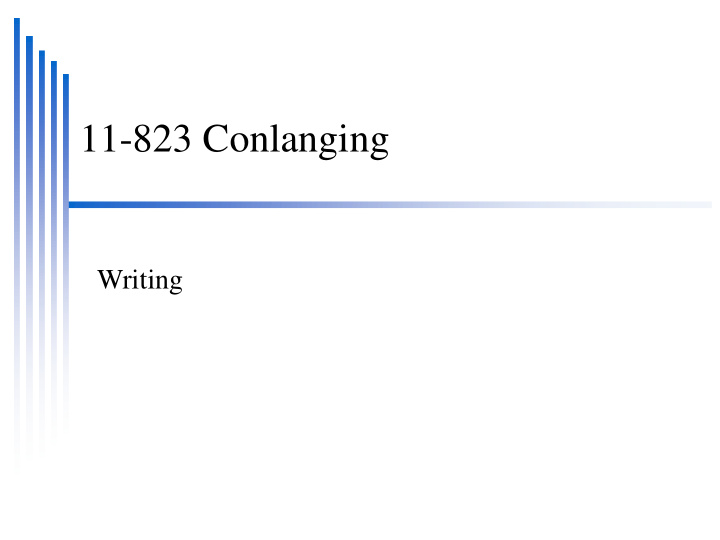



11-823 Conlanging Writing
Writing Systems Different Writing Systems What makes a writing system Standardization vs Historical artifacts Constructed Writing Systems Computing and its influence on writing
Types of Writing Systems Sampson 1985: – Logographic systems: Chinese – Phonographic Systems: • Syllabic: Linear B • Consonantal: West Semitic • Segmental: Greek • Featural: Hangul
History of Writing Earliest writing systems – Mesopotamia around 3200BCE – Mesoamerica around 600BCE – China around 1200BCE But there is considerable controversy More than numbers – Markings, counting beads ... More than painting pictures/signs
Writing Development Picture Writing – Represent actual objects, times, etc Transitional – Representing the abstract ideas Phonological – Represent things with similar sound
Writing Uses Taxes, taxes and taxes – Record who owns what when – How much you have to pay Rules, religions – Laws (Hammurabi ~1770BCE) – Fortune telling (Oracle Bones ~1300BCE) Histories/Literature – Early authors whose names we know – Plahhotpe (Egypt) and Enheduanna (Sumerian) 2400BCE
What things are writing? Known writing systems follow Zipf's Law – Some things are very frequent – Some things are very infrequent But things that follow Zipf's Law – May or may not be writing – Indus Script – Amish Barn Symbols – Linear A
How is Writing Done Often influenced by the medium Cuneiform – easy to cut in stone/paper – – Cursive script ( 書法 ) Often borrow someone else's script – Chinese Characters for Japanese – Latin script for Vietnamese – Latin script for English
Direction Left to right: English Right to left: Arabic Vertical (right to left): Chinese/Japanese Boustrophedon (like an ox) – Left to right to left: Ancient Greek Direction the faces look: Mayan
Skilled and become stylized
Skilled and become stylized 土 火 水 風
Stylized Decorative
Stylized not so decorative
Alphabetic Order How does this occur? – Well its the order of the alphabet – Phonetic (ish) Ordering – By tables (Sanskrit, Japanese Kana) By unicode/ascii order – (That came later) By order of the stars/Kings
Writing Distinctions Upper and Lower Case – Case was the printer's case – (why do European languages have this) Language origin spelling artifacts – Ph and gh in English (Greek, Germanic) – Silent initial w and k – Wales vs Whales – Japanese (Kanji, Hiragana, Katakana)
Writing causes Standardization Removal previous supported letters Ye Olde … – Þ deleted from alphabet so replaced with y So “Ye” is still pronounced “the” – Menzies, Culzean, Dalzell, MacKenzie – Ȝ deleted from alphabet so replaced with z – (mostly old Scots names) Often printings encourages more standardizations – Æ, ß (f in English and ss in German) But new letters too – @ & % (its about taxes again)
Writing causes Standardization Removes dialectal variations – Jail vs gaol – Tuppence, thruppence Back correction of pronunciation – Forehead – Awry, indictment
Constructed Writing Systems Hangul – Phonetically defined
“New” writing systems Vietnamese – Up to 19 th Century Hanzi based – Replaced with Romanization plus diacritics Gaelic – Did match (19 th Century) pronunciation Ojibwe (Anishinaabe/Chippewa) ᓂᔑᓈᐯᒧᐎᓐ (19 th Century) – Musical notation
“New” writing systems Vietnamese – Up to 19 th Century Hanzi based – Replaced with Romanization plus diacritics Gaelic – Did match (19 th Century) pronunciation Ojibwe (Anishinaabe/Chippewa) ᓂᔑᓈᐯᒧᐎᓐ (19 th Century) – Musical notation
AAC Languages Minspeak Blissymbols
Contemporary Writing Influences Computer/Typewriter influenced “two spaces” between sentences – – not in unicode so can't use it – New symbols :-) – 'Labelling' is now 'labeling'
Contemporary Writing Influences All input is romanized – Indic languages – Chinese, Japanese use roman as input Many languages have romanized version – Arabizi, Greeklish – Romanagari
Recommend
More recommend